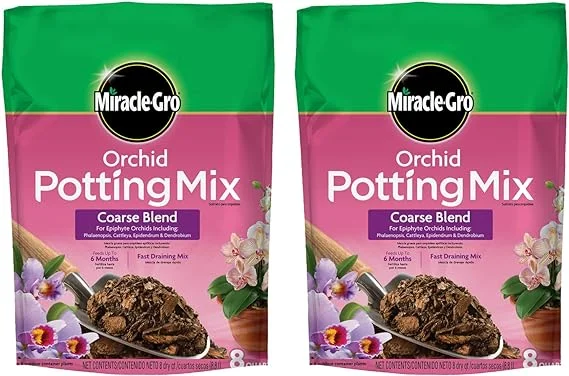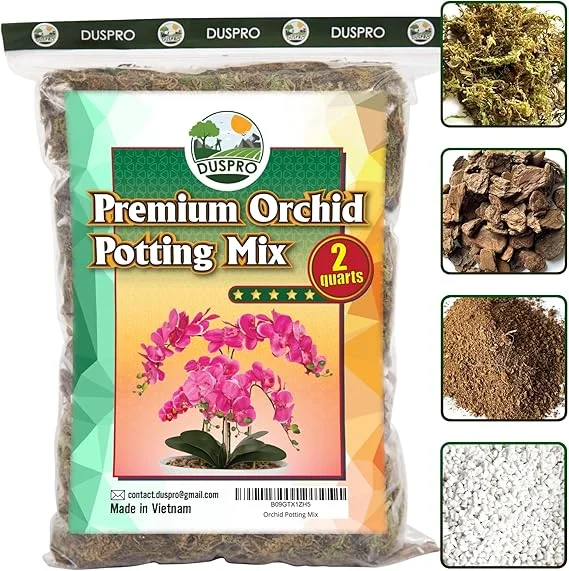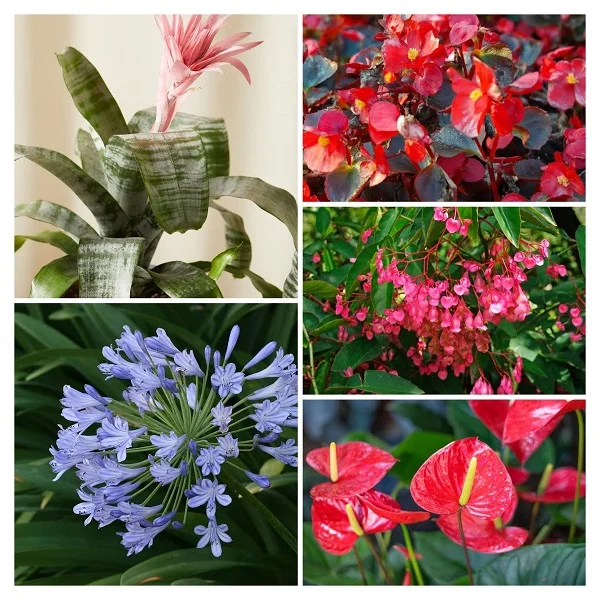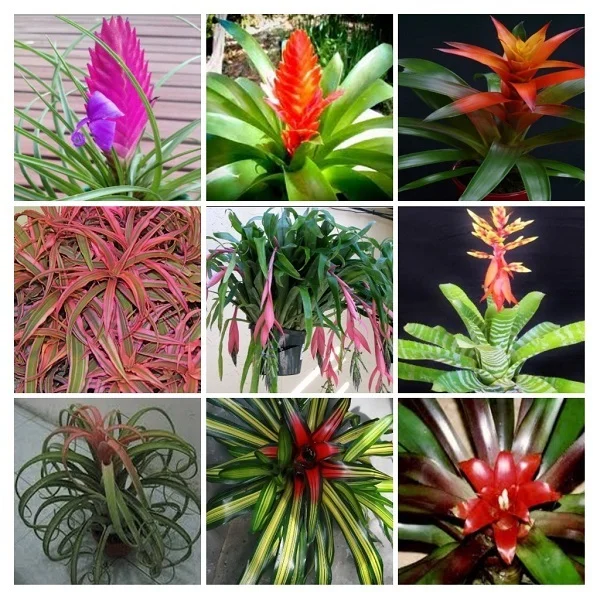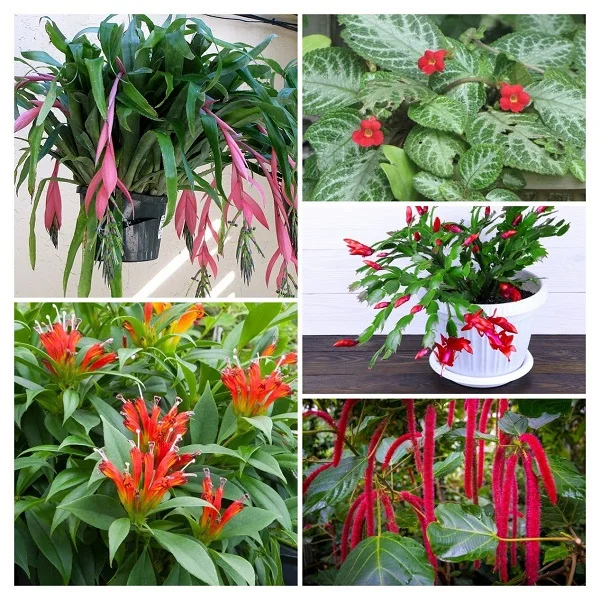Leopard Orchid (Ansellia africana) Indoor Care, Propagation, Problems and Solutions
Some links in this post may be affiliate links
Ansellia orchid (Leopard Orchid) requires very bright light and a dry rest of about 4-6 weeks to produce blooming. They are very drought tolerant but they perform better if kept evenly moist throughout the year.
Leopard Orchids are a rare and fascinating orchid species. This guide covers how to care for Ansellia africana, propagate it successfully, and address common problems to ensure a thriving plant. But first, let's look at some facts about these orchids.
Ansellia orchids also called Trash Basket are popular orchids with leopard-like spotted flowers which gives them the common name, 'Leopard Orchids'.
The common name "Trash Basket" is in reference to their habit of creating a makeshift container (basket) of aerial roots to catch falling leaf litter for nutrients. This basket catches the decaying leaves and litter upon which the plant feeds.
Unlike Cymbidium Orchids (Boat Orchids), Trash Basket Orchids have white, needle-like aerial roots which point upwards, taking the form of a basket around large, yellow, cane-like pseudobulbs.
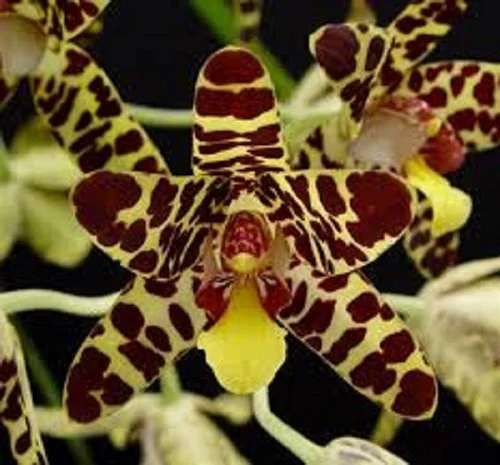
Botanical name: Ansellia africana
Tribe: Cymbidiieae
Subtribe: Cymbidiinae
Common names: Leopard Orchid, Trash Basket
Origin
Ansellia africana are native to tropical and southern Africa. They are found alongside coasts and rivers in the canopy of trees.
John Ansell, an English assistant botanist named Leopard Orchids in 1841 when he found the first plant in Fernando Po Island in West Africa. The genus name is abbreviated as Ansel or Aslla in horticultural journals.
Size
Leopard Orchids are large, perennial epiphytes in their native habitat where they are found sometimes in spectacular clumps attached to the branches of tall trees.
Flower
The pseudobulbs in Leopard Orchids give rise to the tall flower-spikes about 2.5 feet tall with many (upto 100) delicately scented flowers. The flowers are short-lived, lasting about 10 days only but they are produced in abundance.
Medicinal Uses
Leopard Orchid is listed as an endangered species due to overexploitation and destruction of its natural habitats. The orchid has been shown to have some medicinal uses in the treatment of Alzheimer's disease.
Is the Leopard Orchid toxic?
Leopard Orchids are non-toxic to both humans and pets. They are safe for cats, dogs and other pets. You can comfortably grow these orchids in a home with children and pets.
Where to Buy
If you would like to add orchids to your collection, they are readily available online on Etsy (Link to Etsy).
How do you take care of a Leopard Orchid indoors?
To care for Leopard Orchid indoors give it very bright light with 4-6 hours of direct sunshine, average warmth of 16-290C, humidity of 60-75% and moderately moist, rich, well drained, orchid potting soils coupled with fortnightly feeding in the growing season.
Ansellia africana Orchid care requires repotting only when growth begins to suffer or when the growing medium is completely broken down. Pruning is necessary to keep the plant neat as well as discourage pest and disease infestations. Keep reading for more on these growing conditions and how to provide them.

Watering
For lush growth and regular blooms, water your Leopard Orchid thoroughly during the growing period and allow the top 2-3 inches of soil to dry out between waterings. Keep the soil moderately moist but never soggy to avoid rotting.
Cut down on watering in the cold period (fall and winter) as growth is minimal at this time. Do not allow the soil to dry out completely as it can result in wrinkled pseudobulbs and drooping leaves.
Use lukewarm, chlorine-free water as the orchids are sensitive to chlorine and other chemicals dissolved in water and may lead to black leaf tips. Avoid wetting the foliage to discourage fungal diseases.
Give Leopard Orchids a dry spell of about 4-6 weeks, every 6 months to promote blooming. In their natural habitat, they usually bloom at the end of a dry spell.
Take care not to overwater; Leopard Orchids are more tolerant of dry soil conditions than Lady Slippers Orchids (Paphiopedilum Orchids) due to the presence of large pseudobulbs and thick leaves.
Light Requirements
Leopard Orchid thrive in very bright light with 4-6 hours of morning or late evening sunshine. Keep it away from hot midday sunshine to avoid scorching of the leaves.
If the natural lighting is not adequate, consider investing in a grow light to supplement it as too little light may result in weak growth and fewer blooms.
The normal leaf coloration in Leopard Orchid is yellowish-green. Dark-green leaves indicate that the orchid is not receiving enough light while yellow leaves indicate too much light.
Pro tip: Regularly turn the pot to ensure that it gets adequate light on all sides for even growth and prevent unbalanced growth.
Temperature and Humidity
Ansellia africana flourishes in average warmth of 16-290C. The warmer days and cooler night temperatures are ideal for these orchids. Cool nights are essential to trigger flowering.
Keep the orchids away from drafts to avoid sudden changes in temperatures as they can negatively affect growth. Ensure there is good air circulation as these orchids cannot tolerate hot and stuffy conditions.
High humidity of 60-75% is essential for Leopard Orchids to thrive. Low humidity may result if flowerbud drop and brown leaf tips and esdges. To raise humidity, set the pot on a wet pebble tray or use a humidifier.
Pro tip: Do not mist the leaves and ensure good airflow to minimize fungal diseases infestations.
Feeding
Feed your Ansellia africana with a nitrogen-rich, water-soluble orchids fertilizer every two weeks during the growing season (spring and summer) for healthy growth.
For strong blooms, switch to a high-phosphorus fertilizer before flowering. Do not feed an orchid that is in flower.
Stop feeding in the cold season (fall and winter) as growth is minimal. Therfore, feeding at this time may result in fertilizer burn and death of the orchid.
If Leopard Orchids are not receiving adequate nitrogen, they will start growing a trash basket with numerous non-absorbing roots growing upwards.
In feeding, it is better to err on the side of underfeeding than overfeeding as can result in the loss of roots and death of the orchid. It can also lead to vegetative growth instead of flower production.
Potting Mix
The best potting mix for Leopard Orchid should be a rich, loose, well-draining bark soil to prevent it from getting soggy while providing the required nutrients. A mix of 50% Orchid bark, 30% Charcoal (to improve aeration) and 20% Perlite or sphagnum moss is ideal for this orchid.
Repotting
Leopard Orchids bloom best when they are pot-bound. Repot only when growth begins to suffer, shortly after blooming is over. Repot when the orchid has outgrown its pot and the new growth reaches out over the edge of the pot or when the soil has broken down completely.
Use a pot with proper drainage holes or slits as the roots need good air circulation. The pot should be only 1 size larger than the current one. Check out these orchid pots with a free slotted orchid pot liner on Amazon.
When repotting, shake off excess soil and trim off any dried and shrivelled pseudobulbs. Use loose, free-draining bark soil.
Pruning & Grooming
Pruning Ansellia africana involves:
- Trimming the spent flower spikes after blooming to encourage new growth.
- Removal of dead and diseased leaves to keep the plant neat as well as discourage pest and disease infestations.
- Cut the leaves at the base with a sharp, clean knife or pair of pruning scissors.
- Make clean cuts and avoid injuring the orchid unnecessarily to avoid fungal diseases.
Pro tip: Occasionally clean the leaves by damp-wiping with a soft cloth to get rid of dust and minimize pests infestations.
Propagation
Leopard Orchid (Ansellia africana) can be propagated at the beginning of the growing season once flowering is over by division of the rhizome.
How to propagate Leopard Orchid from rhizomes
- Carefully remove the orchid from its pot and find natural divisions where 3-4 healthy pseudobulbs are attached.
- With a clean knife or pruning scissors, gently split the rhizome into sections. Retain at least 3 shoots on each section.
- Seperate the roots attached to each division from the mother's root ball. Remove the old potting soil attached to the roots.
- Select a pot about 1-2 inches larger than the pseudobulb. Ensure the pot has enough drainage holes and slits to prevent rotting.
- Fill the pot with orchids potting mix and place each section in the center of the pot and bury the roots in the soil. Ensure that the bottom of the pseudobulb is level with the top of the soil.
- Water the soil lightly and stake each newly repotted plant to prevent it from toppling over.
- Place the set up in a warm, well-lit place and maintain the soil moist until the new orchids establish their own roots after which you can begin routine care.

Ansellia africana Problems & Remedies
Leopard Orchid (Ansellia africana) problems are yellow leaves, brown leaves, lack of blooms, drooping leaves, black leaf tips, diseases and pests all of which are due to improper care. Keep reading for more on these problems and how to fix them.
Yellow leaves
Some of the causes of yellow leaves on Leopard Orchid are overwatering, soggy soil, too much sunlight and nutrient deficiency.
How to fix it
Overwatering: Do not water on a schedule. Water only when the top 2-3 inches of soil dry.
Soggy soil: Use a loose, bulky, potting soil and a pot with adequate drainage holes or slits.
Too much sunlight: Keep the orchid away from too much sunlight or filter excess sunlight with a light curtain.
Nutrient deficiency: Apply a quality orchid's fertilizer every 2 weeks in spring and summer.
Brown leaves
Some of the causes of brown leaves on Leopard Orchid are hot sunlight, underwatering, extreme temperatures, and fertilizer burn.
How to fix it
Hot sunlight: Keep the orchid away from hot midday sunshine or filter the light with a sheer curtain.
Underwatering: Water when the top 2-3 inches of soil dry.
Extreme temperatures: Keep the orchid away from sources of drafts like windy doors, stoves, heat sources, AC units among others.
Fertilizer burn: Avoid too much fertilizer and do not feed in fall and winter.
Lack of blooms
Lack of blooms on Leopard Orchid is caused by too little light, underfeeding, dry air, and lack of temperature variation.
How to boost blooming in a Leopard Orchid
Too little light: Position the orchid in a brighter spot or use a grow light to supplement insuffucient light.
Underfeeding: Feed the orchid fortnightly in spring and summer with a nitrogen-rich, water-soluble, orchid fertilizer.
Dry air: Set the pot on a wet pebble tray or use a cool mist humidifier to increase humidity.
Lack of temperature variation: Expose the orchid to cooler nights to trigger blooming; a difference of 10-150C is needed.
Limpy, drooping leaves
Limpy, drooping leaves on Leopard Orchid are due to underwatering, temperature stress, and hot sunshine.
How to fix it
Underwatering: Water the orchid when the top 2-3 inches of soil feel dry to the touch. Do not allow the soil to dry out completely.
Temperature stress: Keep the plant away from drafts to avoid extreme temperatures.
Hot sunshine: Place the plant away from hot sunlight or use a light curtain to filter the light.
Black, dying leaf tips
Black, dying leaf tips on Leopard Orchid are due to use of hard water or salts buildup from fertilizers.
How to fix it
Hard water: Use chlorine-free water like rain water, filtered water or distilled water.
Salts buildup: Flush out accumulated salts from the soil by running a stream of water through the soil until it comes out through the drainage holes.
Brown, hard, dry leaf spots
Brown, hard, dry leaf spots on Leopard Orchid are scorch marks caused by exposure to hot direct sunlight. Place the orchid in a shadier spot or instal a light curtain to filter the sunlight.
Diseases
Leoparad Orchid is prone to powdery mildew which presents as mold on the leaves. The disease is common in overwet conditions coupled with poor air circulation.
How to fix it
- Cut and discard the affected leaves to minimize spread of the disease.
- Improve ventilation and ensure that there is good air flow for the orchid.
- Do not mist the orchid; use alternative techniques to raise humidity.
- Avoid wetting the foliage during watering.
Pests
Leopard Orchids are prone to mealybugs, scale insects, slugs and snails infestation. Isolate the affected orchid to prevent spread to other plants and treat it with neem oil or insecticidal soap. Take care to follow the manufacturer's instructions.
Conclusion
Leopard Orchid (Ansellia africana) is a beautiful and unique plant that thrives with proper lighting, moderate watering, and occasional pruning. By following these care, propagation, and troubleshooting tips, you can enjoy healthy growth and stunning blooms for years.
You liked it? Share on social media.
Related Content
Amazon Associates Disclosure
Homeplantsguide.com is a participant in the Amazon Services LLC Associates Program, an affiliate advertising program designed to provide a means for sites to earn advertising fees by advertising and linking to amazon.com.

